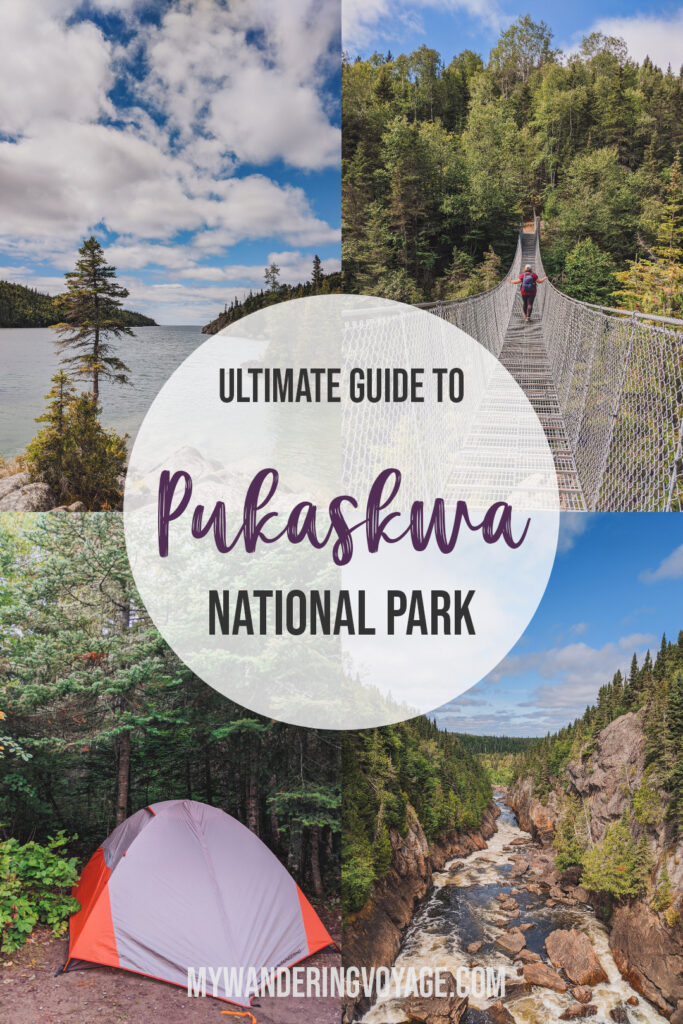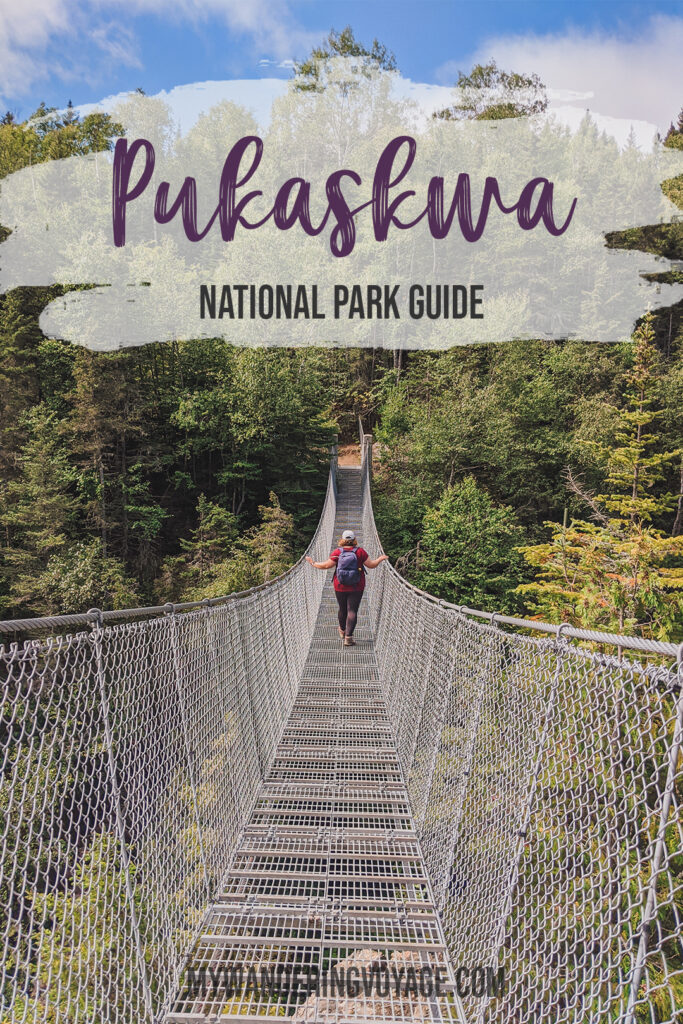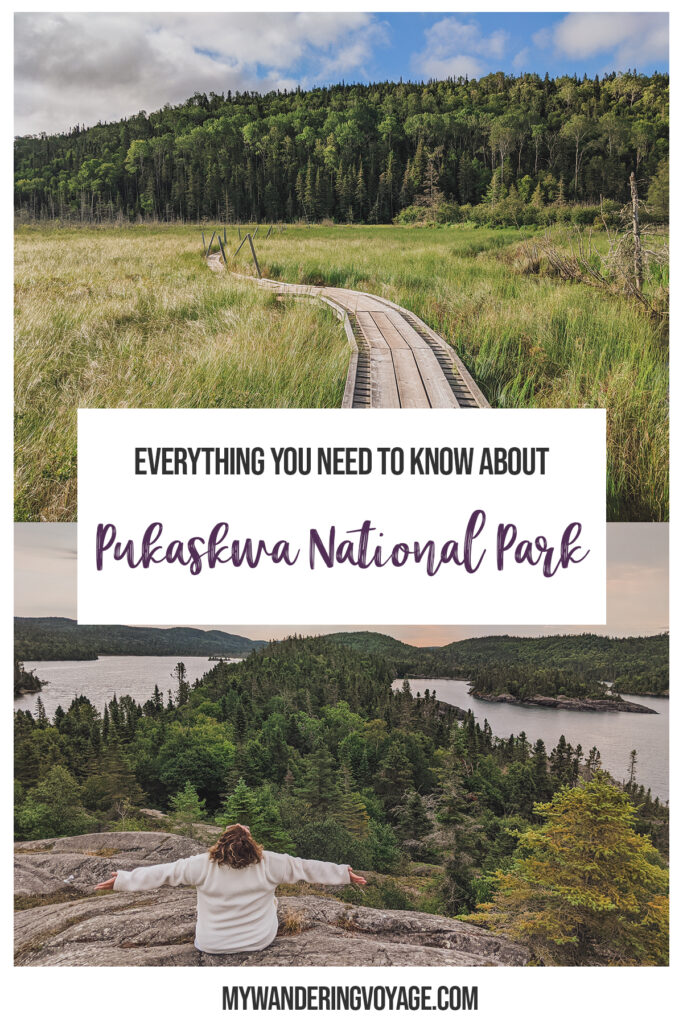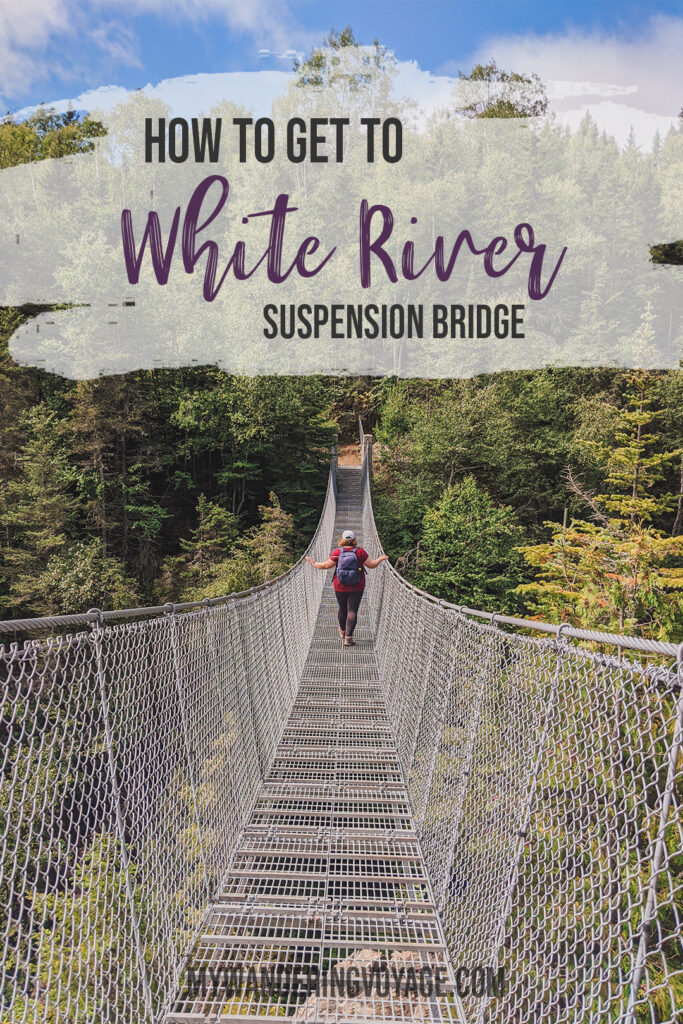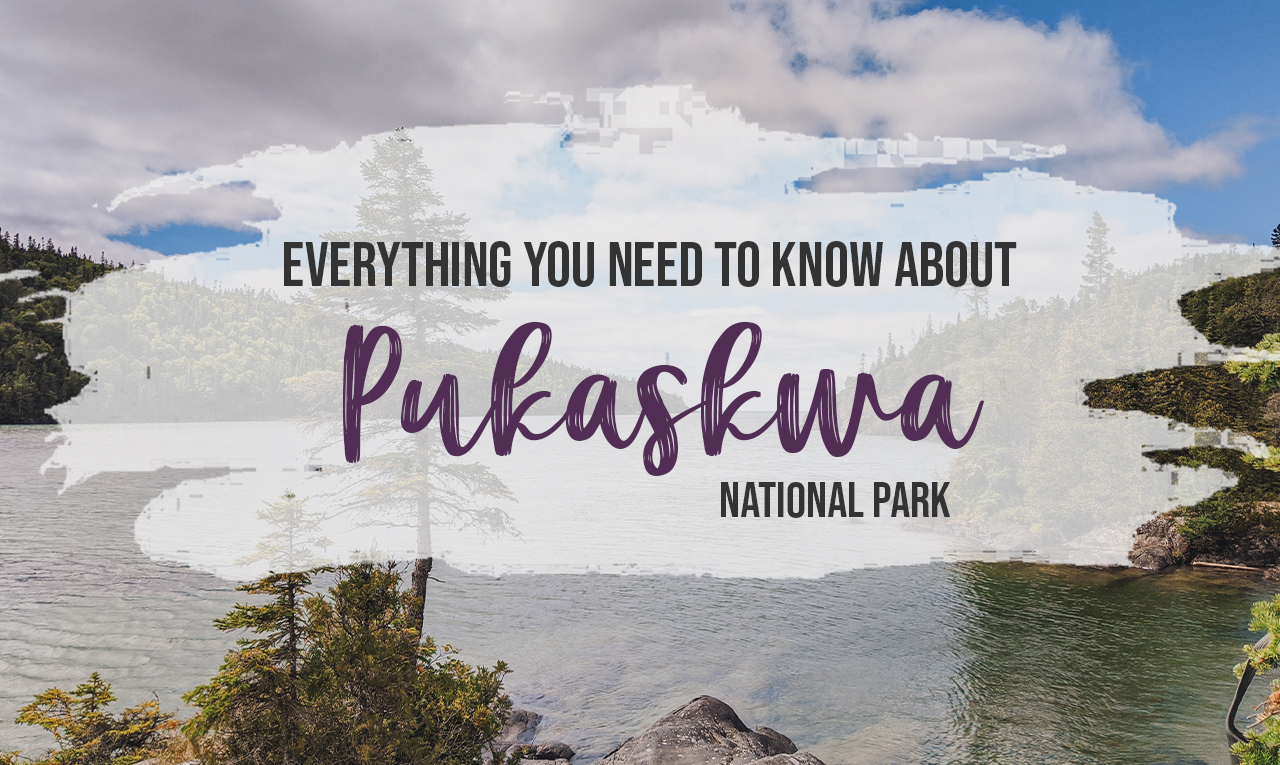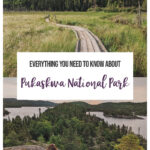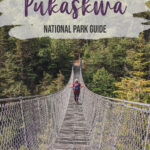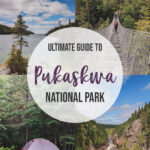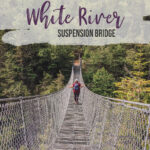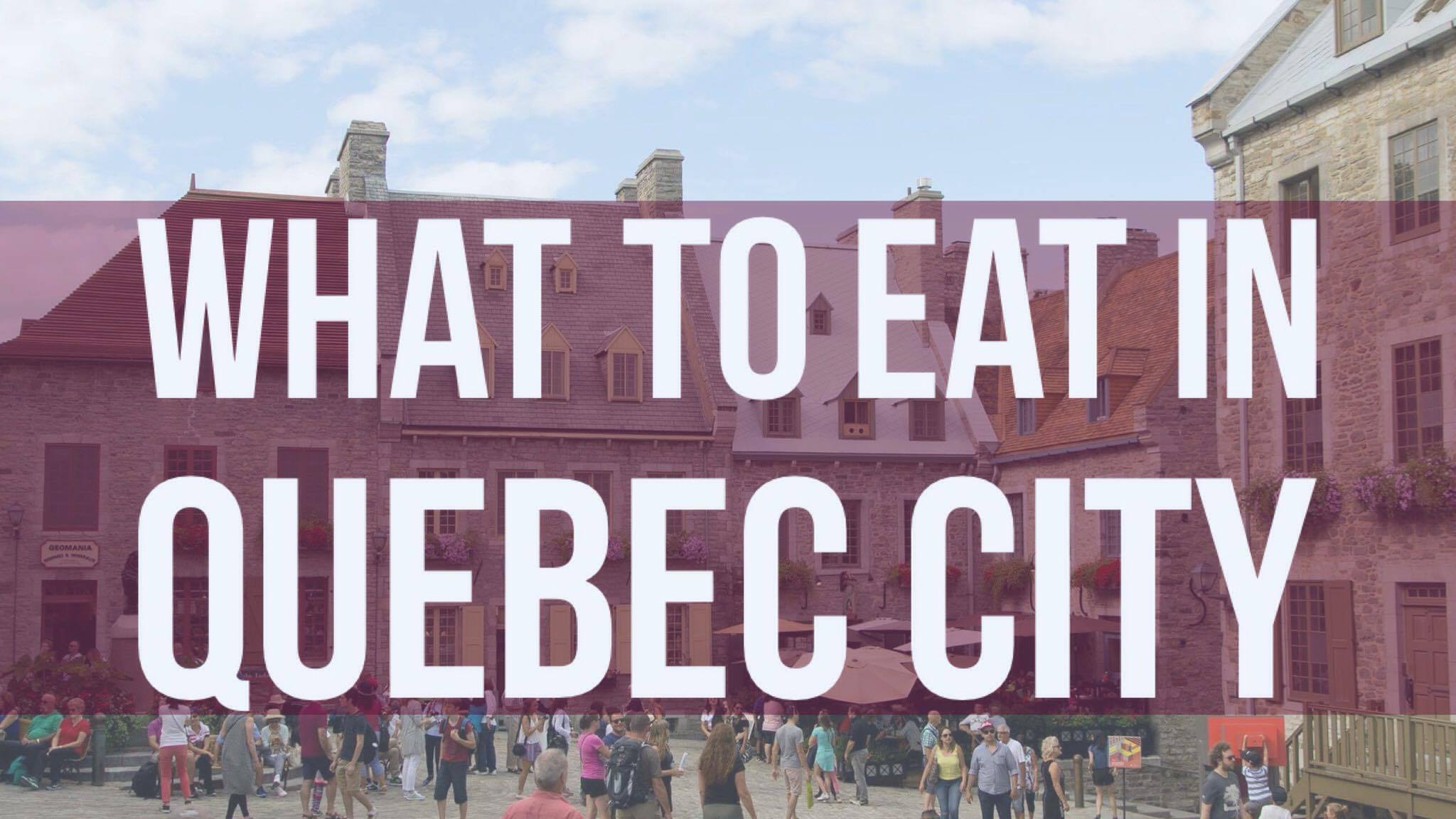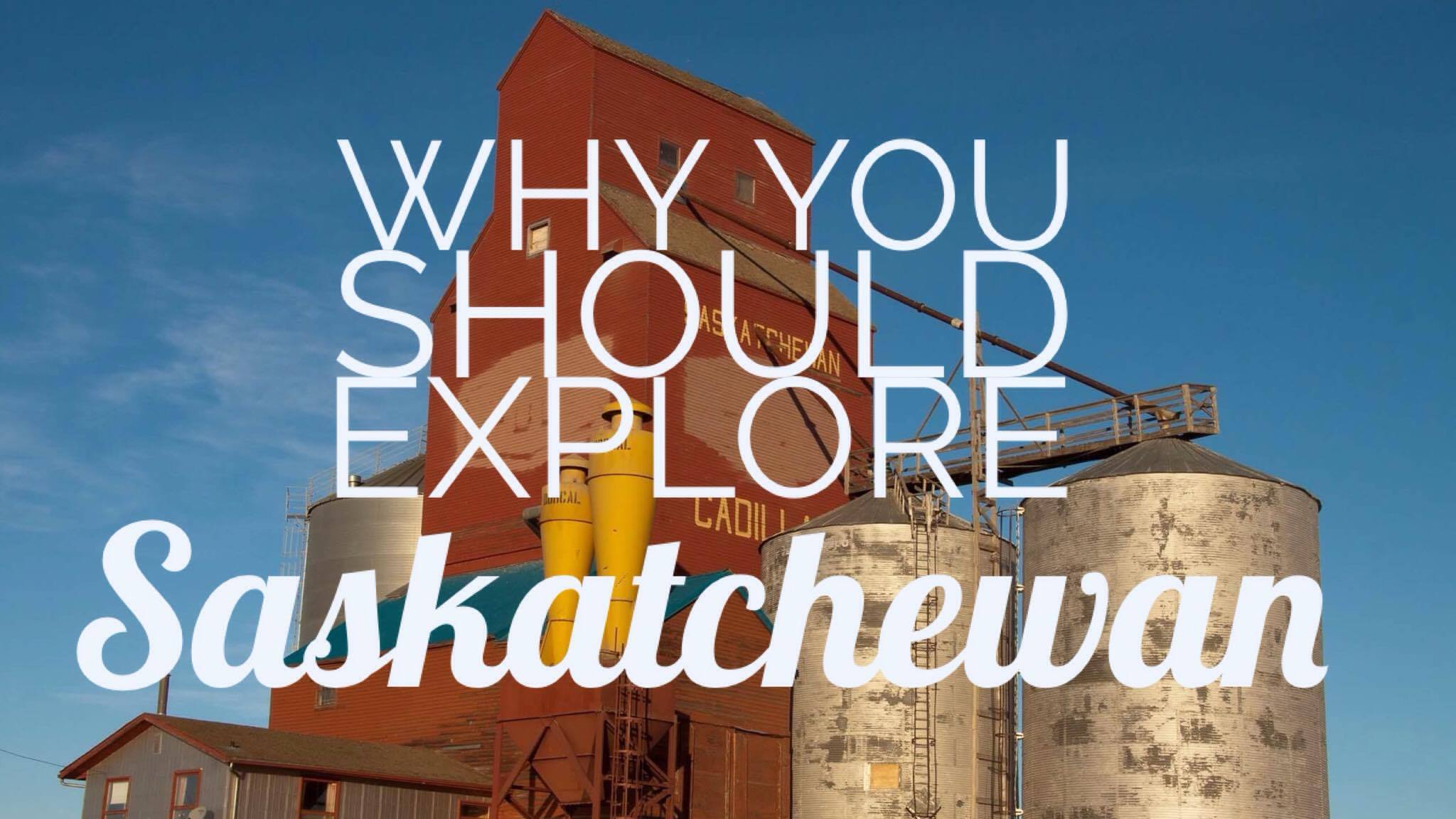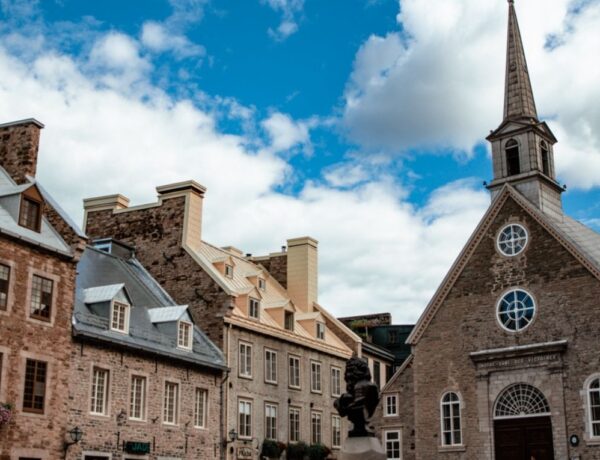Of the six national parks that call Ontario home, Pukaskwa National Park feels the most remote. Located on the shores of Lake Superior and surrounded by thousands of square kilometres of forest, it truly feels like you’re in the middle of nowhere. This guide to Pukaskwa National Park explores everything you need to know about hiking, camping and enjoying this stunning park (and even how to get to the famous White River Suspension Bridge). With ample hiking opportunities and gorgeous landscapes, you won’t want to miss this spectacular park.
NOTE: Travel is not recommended at this time. These posts are here to serve as inspiration when we can explore again. Hey there – this post likely contains affiliate links, which means I earn a commission (at no extra cost to you) if you purchase from them. This helps me earn a few dollars to run this website.
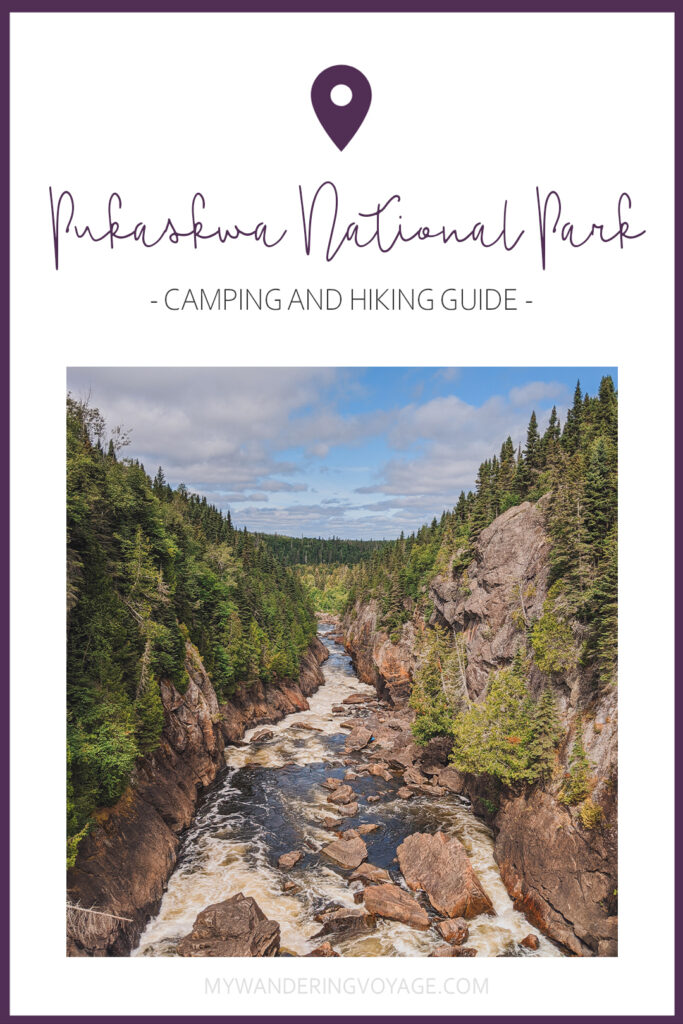
When we first rolled into Pukaskwa National Park, the park was covered in a thick blanket of fog. The tips of the trees were obscured from our view, and sounds were muffled, nearly silent. Unlike the US-portion of the Lake Superior, the northern shore is rugged and remote. Pukaskwa National Park, which makes up about 1,900 sq. km. of forest and coastline, is the perfect example of the beauty of Lake Superior.
Pukaskwa National Park has some of the best hiking and camping in the province. You can also swim (if you’re brave enough), try your hand at backcountry camping, and find the best vistas overlooking Lake Superior.
About Pukaskwa National Park
![Pukaskwa National Park | Everything you need to know about Pukaskwa National Park [+ hiking guide] | My Wandering Voyage travel blog #Pukaskwa #NationalPark #Canada](https://mywanderingvoyage.com/wp-content/uploads/2020/09/Lake-Superior-Road-Trip-092-web-1024x819.jpg)
Located along the shores of Lake Superior, near Marathon, Pukaskwa (Pronounced PUCK-a-saw) National Park has some of the most beautiful and dramatic landscapes of Northern Ontario. It is the largest of the six national parks in Ontario, and it’s also the least accessible.
It’s nearly 12 hours of driving from Toronto, almost four hours from Thunder Bay and five hours from Sault. Ste. Marie. The nearest town of Marathon is the only place you’ll find a motel, which means you’ll want to visit Pukaskwa National Park for a multi-day camping trip to get the most out of it.
It also feels quite remote. Most of the time, you’ll hear nothing but the crash of waves against the shore, the loon calls on the water and the rustle of leaves in the wind. It feels like paradise.
![White River Suspension Bridge | Everything you need to know about Pukaskwa National Park [+ hiking guide] | My Wandering Voyage travel blog #Pukaskwa #NationalPark #Canada](https://mywanderingvoyage.com/wp-content/uploads/2020/09/Lake-Superior-Road-Trip-103-web-1024x819.jpg)
Pukaskwa National Park is home to the Anishinaabe culture and adjacent to Biigtigong Nishnaabeg (Pic River) First Nation. The Indigenous culture has been woven into the fabric of Pukaskwa National Park, evidenced through the Visitor Centre exhibits, Anishinaabe camp, informative signs and more.
Parks Canada and local First Nations groups have partnered to bring visitors together to experience the beauty of this mystical place. At this park, you’ll see gorgeous landscapes of pines, find the smooth granite of the Canadian Shield, rest on the soft sandy beaches, listen to the call of the loons, and maybe even see a bear or moose that call this park home.
There’s honestly so much to do in Pukaskwa, hiking, camping, backpacking, swimming, exploring, wildlife viewing, and so much more. The best part of this park is that you could stay here forever and only see a sliver of it.
RELATED: The Ultimate Guide to National Parks in Ontario
How to get to Pukaskwa National Park
There’s really only one way to get to Pukaskwa National Park, and that’s by car. You can take The Trans-Canada Highway all the way to Highway 627. Once you turn there, you’ll pass through Heron Bay and Ojibways of Pic River First Nation, cross the bridge, and you’ll be in Pukaskwa National Park.
What you need to know about Pukaskwa National Park camping reservations
![Camping at Pukaskwa National Park | Everything you need to know about Pukaskwa National Park [+ hiking guide] | My Wandering Voyage travel blog #Pukaskwa #NationalPark #Canada](https://mywanderingvoyage.com/wp-content/uploads/2020/09/Lake-Superior-Road-Trip-087-web-819x1024.jpg)
There’s nothing quite like camping at Pukaskwa National Park. It just feels so remote and silent; it was probably my favourite place to camp when I went on my Lake Superior road trip. But it also made me the most nervous.
Why, you ask?
Well, Pukaskwa National Park is a first-come-first-serve camping system. There are only 67 camping spots in the Hattie Campground, 37 electrical sites and 30 non-electrical sites. There are also five oTENTiks available for booking. (The oTENTiks and backcountry sites are the only ones you can book online.)
Since it took me a while to figure out that you couldn’t reserve the front-country sites and there was no real information online on how it works, let me break it down for you.
When you arrive at the park, hop out to talk to the people at the gatehouse, they’ll tell you whether or not the campground is full. Then go search for a site. In our case, the whole southern loop was full, and we grabbed one of the few remaining non-electrical campsites in the northern loop. If the campground was full, we would have backtracked to White Lake Provincial Park or head forward to Neys Provincial Park.
Once you pick your campsite, the park rangers suggest you place something there (or in our case, my travel buddy hopped out and stayed at the site while I went back to the gatehouse) to mark that the campsite had been chosen. Then you go back to the gatehouse to check-in and pay.
![Views of Lake Superior at Pukaskwa National Park | Everything you need to know about Pukaskwa National Park [+ hiking guide] | My Wandering Voyage travel blog #Pukaskwa #NationalPark #Canada](https://mywanderingvoyage.com/wp-content/uploads/2020/09/Lake-Superior-Road-Trip-111-web-1024x819.jpg)
Then settle in and set up camp!
Fees for a campsite range from $10 to $120 and change yearly. Be sure to check the fees section of the Parks Canada website for up-to-date admission and camping fees.
Check-in is 2 pm, and check-out is 11 am. There are quiet hours in place from 11 pm to 7 am. Firewood can be purchased at the park gatehouse.
You are in black bear country, so that means you have to keep your campsite bare by placing anything with a scent (food, cooking utensils, toiletries, etc.) away in your vehicle or food storage lockers located at the comfort stations.
RELATED: Beginner’s guide to camping + camping essentials + recipes [free checklist]
Hiking in Pukaskwa National Park
![Hiking in Pukaskwa National Park | Everything you need to know about Pukaskwa National Park [+ hiking guide] | My Wandering Voyage travel blog #Pukaskwa #NationalPark #Canada](https://mywanderingvoyage.com/wp-content/uploads/2020/09/Lake-Superior-Road-Trip-110-web-819x1024.jpg)
I put one foot in front of the other, surrounded by mossy trees, listening. The only sounds came from the swoosh of my pants, the thud of my foot hitting the ground, and the loud chime of my bear bell. We were in bear country, and, as much as I wanted to, I was determined not to see a bear. I knew it was a real possibility since Pukaskwa National Park is in the heart of black bear country in Northern Ontario, but I didn’t want to see one while I was hiking, so far from help.
Hiking in Pukaskwa National Park had to be the most beautiful hiking I had done on my Northern Ontario road trip. That’s because Pukaskwa National Park offers some of the best trails in Ontario. No matter which route you take, you won’t be disappointed.
There are six major trails in Pukaskwa, the Coastal Hiking Trail, Mdaabbii Miikna, Southern Headland Trail, the Beach Trail, Manito Miikana, and Bimose Kinoomagewnan.
The last four are shorter moderate hikes that give you a good taste of Northern Ontario and the stunning but rugged shores of Lake Superior. You can combine these hikes to tour around the whole park, which can take about 3.5 to 4 hours.
Let’s talk about those first.
Southern Headland Trail
![Views of Pukaskwa National Park, Lake Superior, Northern Ontario | Everything you need to know about Pukaskwa National Park [+ hiking guide] | My Wandering Voyage travel blog #Pukaskwa #NationalPark #Canada](https://mywanderingvoyage.com/wp-content/uploads/2020/09/Lake-Superior-Road-Trip-118-web-1024x819.jpg)
This 2.2km trail leads you around the southern arm of Horseshoe Bay. Leaving from the visitor centre, this hike can take about 1h 15m to complete, especially if you want to take photos as I did. The rugged trail starts by climbing up the smooth rock indicative of the Canadian Shield and taking you to breathtaking views of Pulpwood Harbour. Keep an eye out for tiny arctic-alpine plants and lichens among the rocks.
![Views of Pukaskwa National Park, Lake Superior, Northern Ontario | Everything you need to know about Pukaskwa National Park [+ hiking guide] | My Wandering Voyage travel blog #Pukaskwa #NationalPark #Canada](https://mywanderingvoyage.com/wp-content/uploads/2020/09/Lake-Superior-Camping-WEB-21-1024x683.jpg)
Beach Trail
![Horseshoe Bay beach | Everything you need to know about Pukaskwa National Park [+ hiking guide] | My Wandering Voyage travel blog #Pukaskwa #NationalPark #Canada](https://mywanderingvoyage.com/wp-content/uploads/2020/09/Lake-Superior-Camping-WEB-24-1024x683.jpg)
Starting from either the Northern Loop campground or the Southern Loop campground, this 2km, 1h hike will take you along the three sandy beaches of Pukaskwa National Park. Horseshoe Beach is the most protected and offers calm waters to wade in after a long hike. Be sure to check out the lookout at the end of the boardwalk section, showcasing a “Group of Seven Moment.”
These easels, set up around Ontario, highlight some of the Group of Seven’s greatest work in the places that inspired them. A.Y. Jackson loved painting Pukaskwa and what would eventually become the national park.
Manito Miikana
![Views of Pukaskwa National Park, Lake Superior, Northern Ontario | Everything you need to know about Pukaskwa National Park [+ hiking guide] | My Wandering Voyage travel blog #Pukaskwa #NationalPark #Canada](https://mywanderingvoyage.com/wp-content/uploads/2020/09/Lake-Superior-Camping-WEB-27-1024x683.jpg)
Manito Miikana, “Spirit Trail,” is a 2km extension to the Beach Trail, taking you along the northern arm of Horseshoe Bay. Climb up a rocky ravine to panoramic views of Lake Superior and the Pic River dunes. At the tip of the peninsula, you’ll be greeted with two viewing platforms overlooking the brilliant blue lake and rocky shoreline.
Bimose Kinoomagewnan
Head inland on this 3.7km hike around Halfway Lake. Bimose Kinoomagewnan, the “Walk of Teachings,” will teach you about the Seven Grandfather Teachings from Ojibway elders. Along the way, you can read from interpretive signs about love, honesty, respect, wisdom, truth, humility and bravery and how the next generation has represented these teachings through art. Make sure to take in the gorgeous scenery of Halfway Lake too.
RELATED: The Best Nature Books for your Next Adventure in the Great Outdoors
Coastal Hiking Trail in Pukaskwa National Park
![The Coastal Hiking Trail | Everything you need to know about Pukaskwa National Park [+ hiking guide] | My Wandering Voyage travel blog #Pukaskwa #NationalPark #Canada](https://mywanderingvoyage.com/wp-content/uploads/2020/09/Lake-Superior-Road-Trip-088-web-819x1024.jpg)
The Coastal Hiking Trail is a 60km (120km in-and-out) hiking trail that takes you along Lake Superior’s wildest shores, over cobblestone beaches, steep climbs, narrow bridges, river crossings and driftwood obstacles. But you’re rewarded, more than once, with show-stopping views over Lake Superior. The Coastal Hiking Trail is for expert hikers who have tackled this type of terrain before.
The Mdaabii Miikna is an 11.5km addition to the Coastal Hiking Trail. It’s relatively new but offers stunning vistas of the rocky shores of Lake Superior. There are several backcountry sites along this stretch of trail and some of the most scenic spots. While I didn’t tackle this trail while at Pukaskwa National Park, I overheard a ranger talking about the 1km stretch of trail from Playter Harbor South campground to Picture Rocks North campground as one of the most challenging sections of trail in the park.
However, there is a day-hiking section of the Coastal Hiking Trail that you can enjoy while camping at Pukaskwa National Park.
White River Suspension Bridge via the Coastal Hiking Trail
Hiking to the White River Suspension Bridge is la crème de la crème of Pukaskwa National Park. Getting to the bridge is no easy task. It can take anywhere from 6 to 9 hours along difficult and challenging terrain. The 18km in-and-out hike to the White River Suspension Bridge via the Coastal Hiking Trail is one of the most interesting hikes I’ve ever been on.
![Hiking the Coastal Hiking Trail | Everything you need to know about Pukaskwa National Park [+ hiking guide] | My Wandering Voyage travel blog #Pukaskwa #NationalPark #Canada](https://mywanderingvoyage.com/wp-content/uploads/2020/09/Lake-Superior-Road-Trip-091-web-819x1024.jpg)
The first 4.5km (and also the last 4.5km) was the most challenging part of the hike, but it then evened out into a relatively flat section where it was much easier to walk at a good pace. The view at the suspension bridge was worth it.
Let’s break it down.
The first exciting section of the trail is the Hattie Cove Fire Walk, a 700-metre section of forest that was wiped out in a prescribed burn in 2012. You can barely see the evidence of the fire now since the forest has regrown spectacularly. There are informative signs that explain what happened and why as you walk through this section.
![Hiking the Coastal Hiking Trail | Everything you need to know about Pukaskwa National Park [+ hiking guide] | My Wandering Voyage travel blog #Pukaskwa #NationalPark #Canada](https://mywanderingvoyage.com/wp-content/uploads/2020/09/Lake-Superior-Road-Trip-094-web-1024x819.jpg)
You’ll then follow a relatively easy trail split between boardwalk, boggy trail and rocky terrain as you round Hattie Cove. At the tip of Hattie Cove, you’ll enter the wetland, a stretch of boardwalk that doesn’t even look like it should belong in Ontario.
The next section is the hardest since you’ll have the scramble up and down ravines, over rocks, through tight trail sections, through marshy trail sections before you reach the turnoff for the Playter Harbour campground. It’s worth stopping here to sit on the rocks taking in the view. (Plus, there’s a privy if you need it!)
![The Coastal Hiking Trail | Everything you need to know about Pukaskwa National Park [+ hiking guide] | My Wandering Voyage travel blog #Pukaskwa #NationalPark #Canada](https://mywanderingvoyage.com/wp-content/uploads/2020/09/Lake-Superior-Road-Trip-095-web-819x1024.jpg)
On the next 2.3km section, the trail will start to become more manageable. You’ve still got hills and rocks to tackle, but it’s definitely not as tough. You’ll pass the northern and southern trail entrances of the Mdaabii Miikna.
From the southern entrance of the Mdaabii Miikna, it’s only another kilometre or so to the White River Suspension Bridge. This section was the easiest and flattest. You walk through a mossy forest (which feels like there is a bear around every corner) and only have one more ravine crossing before you reach the bridge.
![White River Suspension Bridge | Everything you need to know about Pukaskwa National Park [+ hiking guide] | My Wandering Voyage travel blog #Pukaskwa #NationalPark #Canada](https://mywanderingvoyage.com/wp-content/uploads/2020/09/Lake-Superior-Road-Trip-108-web-1024x819.jpg)
The White River Suspension Bridge is spectacular. The bridge spans 30 metres across the White River gorge and hangs 23 metres above Chigamiwinigum Falls, a stunning set of rapids on the river that leads from White Lake to Lake Superior.
I loved hanging there, suspended over the most beautiful scenery I’ve ever seen, taking it all in. The White River suspension bridge is one of the most scenic bridges in Ontario. Stopping for lunch here is a great idea, and you’ll get the strength back in your legs to do it all over again on the way back.
RELATED: Canada Travel Guide
Other things to do in Pukaskwa National Park
Hiking and camping are just two of the fantastic things you can do at Pukaskwa National Park. Dive into the Anishinaabe culture, learn about the cultural and natural history of the park and explore the famous shoreline.
Anishinaabe Camp
At Pukaskwa, you can visit the Anishinaabe Camp, which was handcrafted by local knowledge keepers. The camp illustrates a traditional life, but it’s also there to keep the spirit and traditions alive. There are numerous programs held here, such as Nishnaabeg Gkinoohmaaged (“The act of teaching by an Anishinaabe”), where you can learn about plans, art, traditions, history and more from teachers from surrounding Indigenous communities.
Join in the drum circles held regularly at the Anishinaabe camp, where you’ll learn songs, stories and teaching that have been kept over the years.
Visitor Centre
![Views of Pukaskwa National Park, Lake Superior, Northern Ontario | Everything you need to know about Pukaskwa National Park [+ hiking guide] | My Wandering Voyage travel blog #Pukaskwa #NationalPark #Canada](https://mywanderingvoyage.com/wp-content/uploads/2020/09/PXL_20210901_154731157-768x1024.jpg)
Don’t miss checking out the visitor centre, where you can grab free Wi-Fi while exploring the beautiful indoor exhibit showcasing the history of the park and the people that live here.
Paddling
Some of the best views of Lake Superior’s shoreline can only be seen from the water. You can rent canoes or stand up paddleboards (currently $21.50 for 5 hours) from the park, or bring your own and launch it at the Hattie Cove boat launch.
From here, you can explore the calm waters of Hattie Cove, or if you’re more experienced, head out into the rougher waters of Lake Superior.
Swimming
![Lake Superior shoreline | Everything you need to know about Pukaskwa National Park [+ hiking guide] | My Wandering Voyage travel blog #Pukaskwa #NationalPark #Canada](https://mywanderingvoyage.com/wp-content/uploads/2020/09/Lake-Superior-Road-Trip-089-web-1024x819.jpg)
With showers closed for the 2020 season, we knew that we would want to swim at least once. But Lake Superior’s waters are notoriously frigid. At Pukaskwa, you can go for a swim at one of its three beaches, with Horseshoe Bay Beach being the most accessible. This beach of soft sand blends into the calm waters of the lake. And it stays shallow for quite a while as you wade into the waters.
Averaging only 4°C, it’s a refreshing dip. You’ll want to stick closer to shore where it’s warmer, or if you have one, bring a wetsuit to make swimming much more enjoyable.
What to pack for a camping trip in Pukaskwa National Park
![The Coastal Hiking Trail | Everything you need to know about Pukaskwa National Park [+ hiking guide] | My Wandering Voyage travel blog #Pukaskwa #NationalPark #Canada](https://mywanderingvoyage.com/wp-content/uploads/2020/09/Lake-Superior-Road-Trip-097-web-1024x819.jpg)
I’ve put together this beginner’s guide to camping, which includes an extensive list of everything you need to pack for a camping trip and another one for everything you need to pack for a road trip.
For Pukaskwa National Park, you’ll need to think about a couple of extra things to bring:
- Illumination: make sure to bring a powerful flashlight, because Pukaskwa is in the middle of nowhere and is extremely dark.
- Warm clothing: weather on Lake Superior can change drastically. When we were there, it was foggy, sunny, warm, and chilly in a matter of 24 hours. Bring extra sweaters and blankets for this park.
- Hiking boots: you’ll want sturdy and reliable hiking boots for these rocky and slippery trails.
- Wetsuit: swimming in Lake Superior is so much fun, but it’s even better when you’re wearing a wetsuit built for these frigid waters.
Pukaskwa National Park is the least visited National Park in Ontario (and the least visited in eastern Canada.) Which is so surprising to me because it is incredible. The ample hiking opportunities and the gorgeous Lake Superior landscapes make this park one of the best in Ontario. Hopefully, this guide to Pukaskwa National Park will convince you to go and enjoy some of the best Northern Ontario has to offer.
